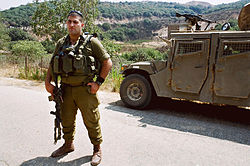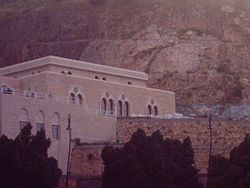- Israeli Druze
-
Israeli Druze 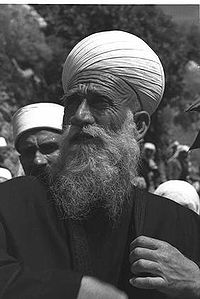
Notable Druze Israelis:
Amin Tarif • Reda Mansour • Muwaffak Tarīf • Assad Assad • Azzam Azzam • Amal Nasser el-Din • Ayoob Kara • Majdi Halabi • Majalli Wahabi
Total population 102,000 (2004)[1] Regions with significant populations  Israel
IsraelLanguages Arabic and Hebrew
Religion The Israeli Druze are a religious minority in Israel. In 2004, there were 122,000 Druze living in the country.[1] In 1957, the Israeli government designated the Druze a distinct ethnic community at the request of its communal leaders.
The Druze are Arabic-speaking citizens of Israel. Since 1948 they have since served in the Israel Defense Forces and the Border Police. They live mainly in the north of the country.[2] Most Druze dissociate themselves from Arab nationalism. [3]Before the establishment of the State of Israel, the community suffered from persecution by Arab nationalists. [4]
Sheikh Amin Tarif was the preeminent religious leader of the community until his death in 1993. [5]
Contents
History
The Druze (Arabic: درزي, derzī or durzī, plural دروز, durūz, Hebrew: דרוזים druzim) are an esoteric monotheistic religious community found primarily in Syria, Lebanon, Israel, and Jordan. The religion incorporates elements of Ismailism, Gnosticism, Neoplatonism and other philosophies. The Druze call themselves Ahl al-Tawhid "People of Unitarianism or Monotheism" or al-Muwaḥḥidūn "Unitarians, Monotheists."
Israeli Druze patriotism
According to the 2008 National Resilience Survey, conducted by Dr. Yussuf Hassan of the Tel Aviv University, more than 94% of Druze youngsters classified themselves as "Druze-Israelis" in the religious and national context.
Druze citizens are prominent in the Israel Defense Forces and in politics. A considerable number of Israeli Druze soldiers have fallen in Israel's wars since the 1948 Arab-Israeli War. The bond between Jewish and Druze soldiers is commonly known by the term "a covenant of blood" (Hebrew: ברית דמים, brit damim), although in recent years the phrase has been criticized as the Israeli government has been accused for failing to open up employment opportunities to Druze youth outside of the army.[6]
Five Druze lawmakers were elected to serve in the 18th Knesset, a disproportionately large number considering their population.[7] Reda Mansour a Druze poet, historian and diplomat, explained: “We are the only non-Jewish minority that is drafted into the military, and we have an even higher percentage in the combat units and as officers than the Jewish members themselves. So we are considered a very nationalistic, patriotic community.”[8]
In 1973, Amel Nasser A-Din founded the Zionist Druze Circle,[9][10] a group whose aim was to encourage the Druze to support the state of Israel fully and unreservedly.[11]
In 2007, Nabiah A-Din, mayor of Kasra Adia, rejected the "multi-cultural" Israeli constitution proposed by the Israeli Arab organization Adalah: "The state of Israel is Jewish state as well as a democratic state that espouses equality and elections. We invalidate and reject everything that the Adalah organization is requesting," he said. According to A-din, the fate of Druze and Circassians in Israel is intertwined with that of the state. "This is a blood pact, and a pact of the living. We are unwilling to support a substantial alteration to the nature of this state, to which we tied our destinies prior to its establishment," he said.[12] As of 2005[update] there were 7,000 registered members in the Druze Zionist movement.[13] In 2009, the movement held a Druze Zionist youth conference with 1,700 participants.[14]
On 30 June 2011, Haaretz reported that a growing number of Israeli Druze were joining elite units of the military, leaving the official Druze battalion, Herev, understaffed. This trend has led to calls for its disbandment.[15]
Religious life
Amin Tarif was the qadi, or spiritual leader, of the Druze in Palestine and Israel from 1928 until his death in 1993. He was highly esteemed and regarded by many within the community as the preeminent spiritual authority in the Druze world.[16]
Sheikh Muwaffak Tarīf (موفق طريف) is the current spiritual leader.
Seven Noahide commandments
In January 2004, Sheikh Mowafak Tarif called on all non-Jews in Israel to observe the Seven Noahide Laws as laid down in the Bible and expounded upon in Jewish tradition. The mayor of the Galilean city of Shefa-'Amr also signed the document.[17] The declaration includes the commitment to make a "...better humane world based on the Seven Noahide Commandments and the values they represent commanded by the Creator to all mankind through Moses on Mount Sinai."[17]
The Druze revere the father-in-law of Moses, Jethro, whom some Muslims identify with Shuʻayb. According to the biblical narrative, Jethro joined and assisted the Jewish people in the desert during the Exodus, accepted monotheism, but ultimately rejoined his own people. The tomb of Jethro near Tiberias is the most important religious site for the Druze community.[17]
Druze of the Golan Heights
Israel occupied the Golan heights in Syria during the Six day war. There are four Druze villages there. In the late 1970s, the Israeli government offered all non-Israelis living in the Golan citizenship, which would entitle them to an Israeli driver's license and enable them to travel freely in Israel. In March 1981, the Druze community leaders imposed a socio-religious ban on Israeli citizenship[citation needed] and in November, a general strike was called that lasted five months and demonstrations were held that sometimes became violent. The Israeli authorities arrested the protest leaders and imposed curfews. On April 1, 1982, a 24-hour curfew was imposed during which soldiers confiscated the old ID cards and replaced them with new ones, signifying Israeli citizenship.[citation needed] This action caused an international outcry including two condemnatory UN resolutions.[18][19] Israel eventually relented and permitted retention of Syrian citizenship.
Today, less than 10% of the Druze of the Golan Heights are Israeli citizens; the remainder hold Syrian citizenship.[20]
In the 2009 elections, 1,193 residents of Ghajar and 809 residents of the Druze villages were eligible voters, out of approximately 1,200 Ghajar residents and 12,600 Druze village residents who were of voting age.[21] During the 2011 Syrian uprising, several rallies of Golan Heights Druzes were held in support of Syrian leader Bashar al-Assad.[22]
Druze localities
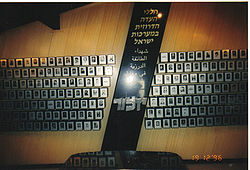 IDF soldiers memorial, Daliyat Al-Karmel
IDF soldiers memorial, Daliyat Al-Karmel
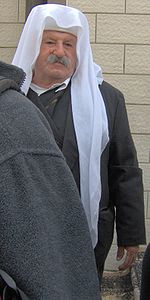 Druze man in traditional dress, Peki'in
Druze man in traditional dress, Peki'in
(Population figures and percentage of overall population):
- Daliyat al-Karmel (15,000 - 96.9%)
- Yirka (14,750 - 98.9%)
- Maghar (11,600 - 57.8%)
- Beit Jann (10,600 - 99.8%)
- Isfiya (8,500 - 80%)
- Kisra-Sumei (7,000 - 94.5%)
- Julis (5,700 - 100%)
- Yanuh-Jat (5,300 - 100%)
- Hurfeish (5,250 - 95.8%)
- Shefa-'Amr (5,150 - 14.1%)
- Peki'in (4,150 - 76.5%)
- Sajur (3,700 - 100%)
- Abu Sinan (3,450 - 27.6%)
- Rameh (2,200 - 30.4%)
In the Golan Heights:
- Majdal Shams (9,700 - 99.9%)
- Buq'ata (5,900 - 99.8%)
- Mas'ade (3,100 - 99.9%)
- Ein Qiniyye (1,735 - 98.9%)
Notable Israeli Druze
Main article: List of Israeli DruzeReferences
- ^ a b Identity Repertoires among Arabs in Israel, Muhammad Amara and Izhak Schnell; Journal of Ethnic and Migration Studies, Vol. 30, 2004
- ^ http://www.jewishvirtuallibrary.org/jsource/Society_&_Culture/druze.html
- ^ http://www.jcpa.org/jl/hit06.htm
- ^ http://www.myjewishlearning.com/israel/Contemporary_Life/Society_and_Religious_Issues/Arab-Israelis/druze.shtml
- ^ Pace, Eric (1993-10-05). "Sheik Amin Tarif, Arab Druse Leader In Israel, Dies at 95". The New York Times. http://www.nytimes.com/1993/10/05/obituaries/sheik-amin-tarif-arab-druse-leader-in-israel-dies-at-95.html. Retrieved 2010-03-29.
- ^ Firro, Kais (2006-08-15). "Druze Herev Battalion Fights 32 Days With No Casualties". Israel National News. http://www.israelnn.com/news.php3?id=110102.
- ^ Elections 2009 / Druze likely to comprise 5% of next Knesset, despite small population
- ^ Christensen, John (Saturday, November 15, 2008). "Consul General is an Arab Who Represents Israel Well". Atlanta Journal-Constitution. http://www.ajc.com/services/content/printedition/2008/11/15/mansour.html. Retrieved 27 June 2010.
- ^ The Druzes in the Jewish state: a brief history By Kais Firro, page 210
- ^ Minorities in the Middle East: a history of struggle and self-expression. By Mordechai Nisan. McFarland, 2002 p. 109
- ^ The Arab minority in Israel, 1967-1991: political aspects By Jacob M. Landau. p. 46
- ^ Stern, Yoav. "Druze, Circassian forum: Israel should remain a Jewish state". Ha'aretz. http://www.haaretz.com/news/druze-circassian-forum-israel-should-remain-a-jewish-state-1.214417. Retrieved 22 June 2010.
- ^ הרצל והתקווה בחגיגות 30 לתנועה הדרוזית הציונית (in Hebrew), by Eli Ashkenazi, Haaretz. Nov. 3, 2005
- ^ "הציונות הדרוזית היא אהבת מדינת ישראל והתרומה למדינת ישראל" (in Hebrew), Radio Haifa, 09/12/2009, by Samar Odeh
- ^ As more young Druze opt for elite units, IDF fears for future of battalion
- ^ Dana, Nissim. The Druze in the Middle East: their faith, leadership, identity and status. 2003. pg.14.
- ^ a b c "Islam Religious Leader Commits to Noahide "Seven Laws of Noah"". Institute of Noahide Code. http://www.noahide.org/article.asp?Level=128&Parent=342. Retrieved 2007-07-15.
- ^ UN
- ^ UN.
- ^ Scott Wilson (2006-10-30). "Golan Heights Land, Lifestyle Lure Settlers". The Washington Post. http://www.washingtonpost.com/wp-dyn/content/article/2006/10/29/AR2006102900926.html. Retrieved 2007-06-05.
- ^ Central Elections Committee, Results of the elections for the 18th Knesset (eligible voters in column D). For age structure, see CBS.gov.il publications. For population, see CBS.gov.il Ishuvim
- ^ Luis Ramirez. "Israeli Druze Keep An Eye Across Fence as Syria Upheaval Unfolds". VOANews.com 2 May 2011. Retrieved 2 May 2011.
Ethnic groups in Israel Jews Arabs Syriacs Assyrians · MaronitesOther Foreign workers
and asylum seekersCategories:- Druze community in Israel
- Ethnic groups in Israel
Wikimedia Foundation. 2010.

